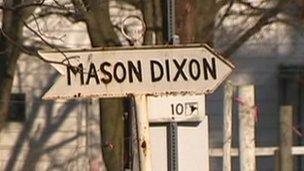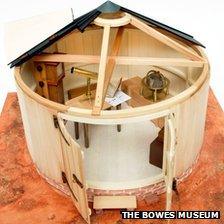Jeremiah Dixon: Exhibition celebrates the 'forgotten' scientist
- Published

The term "Dixie-land" is still recognised today as a reference to the southern states of the USA
A "forgotten" scientist from County Durham who created one of the most famous boundaries in the world, is being celebrated in an exhibition.
Scientist, surveyor and astronomer Jeremiah Dixon was born in Cockfield in 1733.
Throughout his life he travelled the world, most notably observing one of the "best" transits of Venus and defining a boundary between two American states that still holds huge significance for its people today.
A significant historic figure in the United States, Mr Dixon has been largely forgotten in England and, more importantly, in the North East.
Researcher Jonathan Peacock said: "In this country, he has sadly been largely forgotten. Jeremiah made a significant contribution to scientific knowledge at the time, and should certainly be remembered."
Now, an exhibition at The Bowes Museum in Barnard Castle hopes to unveil the history of this bygone scientist.
In 1763, Jeremiah Dixon and fellow astronomer Charles Mason, were approached by Thomas Penn and Lord Baltimore to survey an accurate boundary between their respective territories.
The resulting divide, the Mason-Dixon line, came to signify the border between North and South, separating the free state of Pennsylvania from slave-owning Maryland.
Guided by stars
Aided by a group of Native Americans, the project to map the location of the boundary took five years.
Using constellations as their guide, the surveyors used limestone blocks sent from England as boundary markers, positioning them so that the arms of the appropriate landowner faced either north to Pennsylvania, or south to Maryland.

This replica crown stone showing the arms of the Penn family is on display
One of America's most famous boundaries, it is one that cannot be seen today but one which once tore the country apart nearly 100 years later.
The Civil War broke out more than 150 years ago on 12 April 1861.
Lasting four years, it claimed the lives of more than 600,000 soldiers and an unknown number of civilians. The south was defeated and slavery outlawed.
Mr Peacock said: "He [Jeremiah Dixon] is known to every American because of the Mason-Dixon line, which has such significance in America.
"I would suggest it is probably the second most famous line on the surface of the earth after the equator.
"It is well known throughout the world, it has had political and economic significance, it was the border between the northern states and the southern states during the American Civil War, so yes, his name resonates in history."
The term "Dixie-land" is still recognised today as a reference to the southern states of America.
'Great beauty'
As well as the history of the Mason-Dixon line, the exhibition delves into Mr Dixon and Mr Mason's work observing the transit of Venus across the face of the Sun.
The pair were chosen to carry out the work by the Royal Society and set sail for the island of Sumatra in 1761.
Boarding HMS Seahorse, they were almost immediately ambushed by a French frigate after setting sail, resulting in the death of 11 crewmen and leaving 34 wounded.

This model of the observatory used for the transit of Venus is also on display
The ship had to return to England for repairs and, due to lost time, they instead travelled to Cape Town and built a temporary observatory.
Despite their setback, what they found is said to be one of the most successful observations of the transit in history.
The telescope used to make these observations, some Iroquois Indian artefacts and the journal of Charles Mason are some of the objects featured in the exhibition.
Mr Peacock said: "The observations he and Charles Mason made in Cape Town were the best taken anywhere in the world for that transit, and helped give an accurate estimate of the distance from the earth to the Sun.
"Jeremiah achieved what he did without any background of a rich family or advanced education. He showed that hard work and determination will take you a very long way."
When he was not travelling the world, Mr Dixon spent the rest of his life quietly in Cockfield working as a surveyor for Raby Estates and also surveying Auckland Castle Park and Lanchester Moor.
Jeremiah Dixon: Scientist, Surveyor and Stargazer is on display at The Bowes Museum, external until 6 October.
- Published1 June 2012
- Published14 April 2011
- Published12 April 2011
- Published12 April 2011